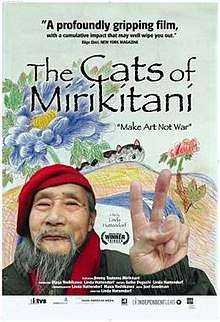The Cats of Mirikitani
The Cats of Mirikitani is a documentary film originally released in 2006.[1][2][3]
| The Cats of Mirikitani | |
|---|---|
 | |
| Directed by | Linda Hattendorf |
| Produced by | Linda Hattendorf Masa Yoshikawa |
| Starring | Jimmy Mirikitani |
| Music by | Joel Goodman |
Release date |
|
Running time | 74 minutes |
| Country | United States |
| Language | English Japanese |
Synopsis
In 2001, Japanese American painter Jimmy Mirikitani (born Tsutomu Mirikitani), over 80 years old, was living on the streets of lower Manhattan. Filmmaker Linda Hattendorf took an interest, and began to engage with him to create a documentary of his life. After the destruction of the World Trade Center on September 11, 2001, the debris- and dust-choked streets were deserted. When Hattendorf "found" Mirikitani, in his usual spot along the wall of a Korean Market, near the intersection of MacDougal and Prince Street in Soho, she offered him shelter in her small apartment. During this period a beautiful and curious friendship flowered, as Ms. Hattendorf began the long process of re-integrating Mr. Mirikitani into society, recovering, among other documents, his social security card and passport. Over the months they lived together, she uncovered his true identity and history. And ultimately, she reunited him with his niece, poet Janice Mirikitani, and his surviving sister and helped him find his own apartment in an assisted living facility.
Over the course of the film, audiences learn about Mirikitani's past, including the injustice experienced by American-born Japanese during the Second World War, his career as an artist, his life among other artists, including Jackson Pollock. Ms. Hattendorf documents Mirikitani's epic journey, from California, to Hiroshima, back to California, to his imprisonment in an internment camp, to his sojourn across the country to Long Island and finally to New York City, where he was employed as a cook. When his employer died, Mirikitani became homeless, spending almost a decade in Washington Square Park. Later, he moved to the streets of Soho, where he created an atelier on the streets, and worked days and nights on his artwork.
Hattendorf's highly personal film about justice deferred, loss, and redemption has won many awards in the United States and abroad, and in the end brought both Hattendorf and Mirikitani well-deserved and hard-won regard. (The "cats" in the title are featured in Mirikitani's artwork.)
In May 2007 The Cats of Mirikitani aired on the award-winning PBS series Independent Lens.
Mirikitani died October 21, 2012, at the age of 92.[4] Director Linda Hattendorf and her collaborator, Masa Yoshikawa, were at Mirikitani's deathbed.[5]
Awards
- Won the Audience Award at the 2006 Tribeca Film Festival.[6]
- Won the Best Picture Award in the Japanese Eyes section of the 2006 Tokyo International Film Festival[7]
- Won the audience award at the 2007 Lyon Film festival (Lyfe / Hors-Ecran)[8]
References
- "Tribeca honours war-themed films". RTÉ. 2006-05-09.
- Marjorie Skinner. "History on Repeat: Our Century in Racial Profiling". Portland Mercury.
- Jennifer Jackson (2011-08-17). "Quilcene turns out for family's story". Peninsula Daily News.
- "'Cats of Mirikitani' Star Dies at 92". Rafu Shimpo. Retrieved 15 January 2013.
- Keiichiro Inoue (2015-09-05). "Film on homeless painter Mirikitani gets revival in Tokyo". The Asahi Shimbun.
Mirikitani died in October 2012 at age 92, six years after the release of "The Cats of Mirikitani." He fell and hit his head at a welfare facility where he was residing and died a few weeks later. Yoshikawa and Hattendorf were at his deathbed.
- Soares, Andre. "2006 Tribeca Film Festival Awards". Alt Film Guide. Retrieved 5 June 2011.
- "TIFF History 2006". Tokyo International Film Festival. Archived from the original on 14 March 2012. Retrieved 5 June 2011.
- "2eme édition - 2007". Hors Ecran. Archived from the original on 17 March 2012. Retrieved 5 June 2011.